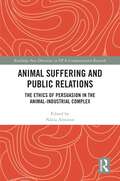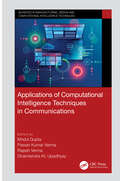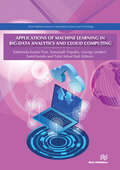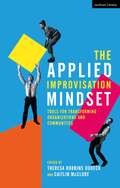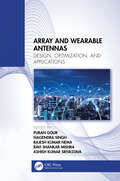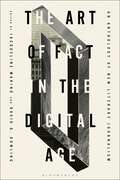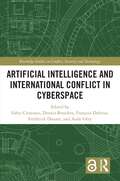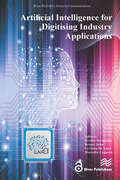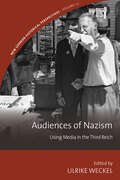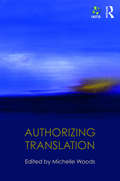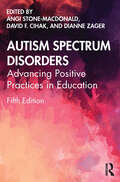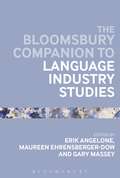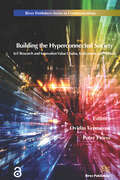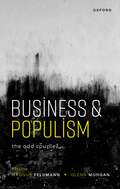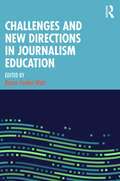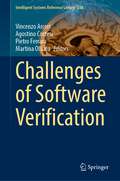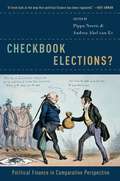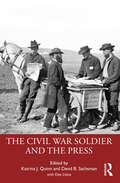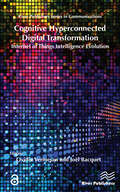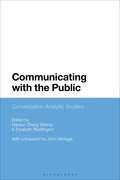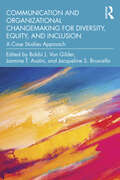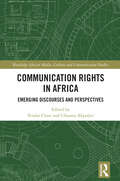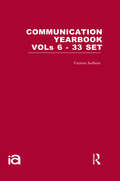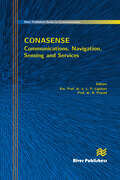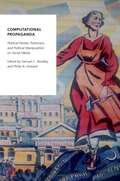- Table View
- List View
Animal Suffering and Public Relations: The Ethics of Persuasion in the Animal-Industrial Complex (Routledge New Directions in PR & Communication Research)
Animal Suffering and Public Relations conducts an ethical assessment of public relations, mainly persuasive communication and lobbying, as deployed by some of the main businesses involved in the animal-industrial complex—the industries participating in the systematic and institutionalised exploitation of animals.Society has been experiencing a growing ethical concern regarding humans’ (ab)use of other animals. This is a trend first promoted by the development of animal ethics—which claims any sentient being, because of sentience, deserves moral consideration—and more recently by other approaches from the social sciences, including critical animal studies. In this volume, we aim to start an entirely unaddressed discussion within the field of public relations: The need to problematise the ethics of persuasion when nonhuman animal suffering is involved, particularly the impact of persuasion and lobbying on compassion towards other animals in the cases of food, experimentation, entertainment, and environmental management. This book provides an interdisciplinary, theoretical discussion illustrated with international case studies from experts in strategic communication, public relations, lobbying and advocacy, animal ethics, philosophy of law, political philosophy, and social psychology.This unique book merges the fields of critical public relations, animal ethics, and critical animal studies and will be of direct appeal to a wide range of researchers, academics, and doctoral students across related fields.
Applications of Computational Intelligence Techniques in Communications (Advances in Manufacturing, Design and Computational Intelligence Techniques)
The book titled "Applications of Computational Intelligence Techniques in Communications" is a one-stop platform for the researchers, academicians, and people from industry to get a thorough understanding of the latest research in the field of communication engineering. Over the past decade, a manyfold increase in the use of computational intelligence techniques has been identified for obtaining the most optimal and timely solution to a problem. The various aspects covering the significant contribution of numerous computational intelligence techniques have been discussed in detail in this book. Today’s era of machine learning and Internet of Things (IoT) is demanding as high as possible data rate which has resulted into tremendous increased speed of communication. To match-up the pace, the computational intelligence is posing to be the most efficient and favourite tool. The book aims to cover the current technological advancements in the field of communication engineering and give a detailed prospect of computational intelligence to its readers. This book will be a great support to the people working in the field of IoT, machine learning, healthcare, optimization, filter design, 5G and beyond, signal processing etc. The chapters included here will expose its audience to various newly introduced and advanced computational intelligence techniques applicable in communication domain. The readers will be exposed multiple interdisciplinary areas of research in communication and will get the motivation to work in collaboration with other professionals from both the academia and industry.
Applications of Machine Learning in Big-Data Analytics and Cloud Computing
Cloud Computing and Big Data technologies have become the new descriptors of the digital age. The global amount of digital data has increased more than nine times in volume in just five years and by 2030 its volume may reach a staggering 65 trillion gigabytes. This explosion of data has led to opportunities and transformation in various areas such as healthcare, enterprises, industrial manufacturing and transportation. New Cloud Computing and Big Data tools endow researchers and analysts with novel techniques and opportunities to collect, manage and analyze the vast quantities of data. In Cloud and Big Data Analytics, the two areas of Swarm Intelligence and Deep Learning are a developing type of Machine Learning techniques that show enormous potential for solving complex business problems. Deep Learning enables computers to analyze large quantities of unstructured and binary data and to deduce relationships without requiring specific models or programming instructions.This book introduces the state-of-the-art trends and advances in the use of Machine Learning in Cloud and Big Data Analytics. The book will serve as a reference for Data Scientists, systems architects, developers, new researchers and graduate level students in Computer and Data science. The book will describe the concepts necessary to understand current Machine Learning issues, challenges and possible solutions as well as upcoming trends in Big Data Analytics.
The Applied Improvisation Mindset: Tools for Transforming Organizations and Communities
How can the practice of improvisation become the lens through which we view the world? The Applied Improvisation Mindset takes readers deep into the maturing field of Applied Improvisation (AI), with stories of 18 practitioners from five countries who embrace an improvisation mindset to create a more collaborative, equitable, sustainable, and joyous world. Myriad organizations have discovered how the mindset and skills applied by great improvisers onstage can reveal emergent, generative ways of interacting with others offstage.With case studies on developing presentation skills, reducing anxiety in teens, or preparing climate risk managers across the globe for the challenges ahead, this second volume serves as a valuable resource for both experienced and new AI facilitators. It is a primer for higher education and K-12 faculty combatting traditional teaching limitations and a practical “how to” for theatre practitioners, artists, educators, or anyone seeking to transform their organizations and communities.
Array and Wearable Antennas: Design, Optimization, and Applications
The text highlights the designing of efficient, wearable, and textile antennas for medical and wireless applications. It further discusses antenna design for the Internet of Things, biomedical, and 5G applications. The book presents machine learning and deep learning techniques for antenna design and analysis. It also covers radio frequency, micro-electromechanical systems, and nanoelectromechanical systems devices for smart antenna design.This book: Explores wearable reconfigurable antennas for wireless communication and provide the latest technique in term of its structure, defective ground plane, and fractal design Focuses on current and future technologies related to antenna design, and channel characterization for different communication links, and applications Discusses machine learning techniques for antenna design and analysis Demonstrates how nano patch antenna resonates at multiple frequencies by varying the chemical potential Covers the latest antenna technology for microwave sensors, and for fiber optical sensor communications It is primarily for senior undergraduate, graduate students, and academic researchers in the fields of electrical engineering, electronics and communications engineering.
The Art of Fact in the Digital Age: An Anthology of New Literary Journalism
The Art of Fact in the Digital Age is a showcase of the most powerful and moving journalism of the past 25 years. Selections include stories originally published in established bastions of literary journalism (The New York Times, The Atlantic and The New Yorker), as well as those from specialized and online publications (Runner's World, The Atavist). It features writers of extraordinary style (including Carina del Valle Schorske, Brian Phillips, and Jia Tolentino), as well as those who have profoundly influenced public discourse on the 21st century's most urgent issues: Mitchell S. Jackson, Clint Smith, and Ta-Nehisi Coates on race; Susan Dominus and Luke Mogelson on migration; and Kathryn Schulz and David Wallace-Wells on environmental threats. It even includes one story that expanded literary journalism's repertoire into audio (This American Life). This collection, assembled for students, scholars, and practitioners alike, also charts the evolution of digital longform journalism through its greatest achievements, from transitioning readers to screens to the integration of multimedia with words in service of meaning. The art of fact in the 21st century opened new ranges of expression to address such issues, while uniquely bearing the imprint of their generation's digital cultures and technologies. Although many forces compete for attention in the digital age, story triumphs. The works in this anthology show us why.
Artificial Intelligence and International Conflict in Cyberspace (Routledge Studies in Conflict, Security and Technology)
This edited volume explores how artificial intelligence (AI) is transforming international conflict in cyberspace. Over the past three decades, cyberspace developed into a crucial frontier and issue of international conflict. However, scholarly work on the relationship between AI and conflict in cyberspace has been produced along somewhat rigid disciplinary boundaries and an even more rigid sociotechnical divide – wherein technical and social scholarship are seldomly brought into a conversation. This is the first volume to address these themes through a comprehensive and cross-disciplinary approach. With the intent of exploring the question ‘what is at stake with the use of automation in international conflict in cyberspace through AI?’, the chapters in the volume focus on three broad themes, namely: (1) technical and operational, (2) strategic and geopolitical, and (3) normative and legal. These also constitute the three parts in which the chapters of this volume are organised, although these thematic sections should not be considered as an analytical or a disciplinary demarcation. This book will be of much interest to students of cyber-conflict, artificial intelligence, security studies and International Relations.
Artificial Intelligence for Digitising Industry – Applications
This book provides in-depth insights into use cases implementing artificial intelligence (AI) applications at the edge. It covers new ideas, concepts, research, and innovation to enable the development and deployment of AI, the industrial internet of things (IIoT), edge computing, and digital twin technologies in industrial environments. The work is based on the research results and activities of the AI4DI project, including an overview of industrial use cases, research, technological innovation, validation, and deployment. This book’s sections build on the research, development, and innovative ideas elaborated for applications in five industries: automotive, semiconductor, industrial machinery, food and beverage, and transportation. The articles included under each of these five industrial sectors discuss AI-based methods, techniques, models, algorithms, and supporting technologies, such as IIoT, edge computing, digital twins, collaborative robots, silicon-born AI circuit concepts, neuromorphic architectures, and augmented intelligence, that are anticipating the development of Industry 5.0. Automotive applications cover use cases addressing AI-based solutions for inbound logistics and assembly process optimisation, autonomous reconfigurable battery systems, virtual AI training platforms for robot learning, autonomous mobile robotic agents, and predictive maintenance for machines on the level of a digital twin. AI-based technologies and applications in the semiconductor manufacturing industry address use cases related to AI-based failure modes and effects analysis assistants, neural networks for predicting critical 3D dimensions in MEMS inertial sensors, machine vision systems developed in the wafer inspection production line, semiconductor wafer fault classifications, automatic inspection of scanning electron microscope cross-section images for technology verification, anomaly detection on wire bond process trace data, and optical inspection. The use cases presented for machinery and industrial equipment industry applications cover topics related to wood machinery, with the perception of the surrounding environment and intelligent robot applications. AI, IIoT, and robotics solutions are highlighted for the food and beverage industry, presenting use cases addressing novel AI-based environmental monitoring; autonomous environment-aware, quality control systems for Champagne production; and production process optimisation and predictive maintenance for soybeans manufacturing. For the transportation sector, the use cases presented cover the mobility-as-a-service development of AI-based fleet management for supporting multimodal transport. This book highlights the significant technological challenges that AI application developments in industrial sectors are facing, presenting several research challenges and open issues that should guide future development for evolution towards an environment-friendly Industry 5.0. The challenges presented for AI-based applications in industrial environments include issues related to complexity, multidisciplinary and heterogeneity, convergence of AI with other technologies, energy consumption and efficiency, knowledge acquisition, reasoning with limited data, fusion of heterogeneous data, availability of reliable data sets, verification, validation, and testing for decision-making processes.
Audiences of Nazism: Using Media in the Third Reich (New German Historical Perspectives #13)
Through its focus on audiences and their reception of media in Nazi Germany, Audiences of Nazism inverts the typical top-down perspective employed in studies that concentrate on the regime’s regulation of media and propaganda. It thereby sheds new light on the complex character of the period’s media, their uses, and the scope for audience interpretation. Contributors investigate how consumers either appropriated or ignored certain messages of Nazi propaganda, and how some even participated in its production. The authors ground their studies on novel historical sources, including private diaries and letters, photographs and films, and concert programs, which demonstrate, amongst other things, how audiences interpreted and responded to regulated news, Nazi Party rallies, and the regime’s denunciation of modern works of art as ‘degenerate.’
Authorizing Translation: The IATIS Yearbook (The IATIS Yearbook)
Authorizing Translation applies ground-breaking research on literary translation to examine the intersection between Translation Studies and literary criticism, rethinking ways in which analyzing translation and the authority of the translator can provide nuanced micro and macro readings of literary work and the worlds through which it moves. A substantial introduction surveys the field and suggests possible avenues for future research, while six case-study-based chapters by a new generation of Literature and Translation Studies scholars focus on the question of authority by asking: Who authors translations? Who authorizes translations? What authority do translations have in different cultural contexts? What authority does Literary Translation Studies have as a field? The hermeneutic role of the translator is explored through the literary periods of Romanticism, Modernism, and Postmodernism, and through different cultures and languages. The case studies focus on data-centered analysis of reviews of translated literature, ultimately illustrating how the translator’s authority creates and hybridizes literary cultures. Authorizing Translation will be of interest to students and researchers of Literary Translation and Translation Studies. Additional resources for Translation and Interpreting Studies are available on the Routledge Translation Studies Portal: http://cw.routledge.com/textbooks/translationstudies.
Autism Spectrum Disorders: Advancing Positive Practices in Education
The fifth edition of Autism Spectrum Disorders: Advancing Positive Practices in Education provides readers with a comprehensive and accessible understanding of current research and evidence-based practices in autism spectrum disorders (ASD), linking research, theory, and practice. This new edition includes new chapters on trauma and co-morbidity, current trends in autism research, social media, neurodiversity, and aging in people with ASD. It also features updated content on international contexts and culturally sustaining and relevant practices. Aligned with DSM-5 diagnostic criteria, this text continues to be critical reading for students and researchers in special and inclusive education programs.
The Bloomsbury Companion to Language Industry Studies (Bloomsbury Companions)
This volume provides a comprehensive overview of the key issues shaping the language industry, including translation, interpreting, machine translation, editing, terminology management, technology and accessibility. By exploring current and future research topics and methods, the Companion addresses language industry stakeholders, researchers, trainers and working professionals who are keen to know more about the dynamics of the language industry. Providing systematic coverage of a diverse range of translation and interpreting related topics and featuring an A to Z of key terms, The Bloomsbury Companion to Language Industry Studies examines how industry trends and technological advancement can optimize best practices in multilingual communication, language industry workspaces and training.
Building the Hyperconnected Society- Internet of Things Research and Innovation Value Chains, Ecosystems and Markets
This book aims to provide a broad overview of various topics of Internet of Things (IoT), ranging from research, innovation and development priorities to enabling technologies, nanoelectronics, cyber-physical systems, architecture, interoperability and industrial applications. All this is happening in a global context, building towards intelligent, interconnected decision making as an essential driver for new growth and co-competition across a wider set of markets. It is intended to be a standalone book in a series that covers the Internet of Things activities of the IERC – Internet of Things European Research Cluster from research to technological innovation, validation and deployment.The book builds on the ideas put forward by the European Research Cluster on the Internet of Things Strategic Research and Innovation Agenda, and presents global views and state of the art results on the challenges facing the research, innovation, development and deployment of IoT in future years. The concept of IoT could disrupt consumer and industrial product markets generating new revenues and serving as a growth driver for semiconductor, networking equipment, and service provider end-markets globally. This will create new application and product end-markets, change the value chain of companies that creates the IoT technology and deploy it in various end sectors, while impacting the business models of semiconductor, software, device, communication and service provider stakeholders. The proliferation of intelligent devices at the edge of the network with the introduction of embedded software and app-driven hardware into manufactured devices, and the ability, through embedded software/hardware developments, to monetize those device functions and features by offering novel solutions, could generate completely new types of revenue streams. Intelligent and IoT devices leverage software, software licensing, entitlement management, and Internet connectivity in ways that address many of the societal challenges that we will face in the next decade.
Business and Populism: The Odd Couple?
Business and Populism analyses the relationship between right wing populism and business with a focus on business responses and strategies in the face of the global populist turn. In the neoliberal era business had become accustomed to favourable economic policy regimes and governance arrangements that facilitated business influence on key policy issues. The rise of populist movements in various parts of the world is widely perceived as a significant challenge to policymaking, mainstream political parties and even to liberal democracy. Yet we know very little about the impact of populism on business, beyond the fact that the anti-elite challenge of populism frequently targets business with policies to restrict globalization, outsourcing, and labour migration whilst at the same time embracing capitalism, low taxes, and deregulated markets. Populists also glory in presenting themselves as authentic representatives of the people, symbolizing this in their demotic language, their rejection of standards of 'polite' society and liberal 'woke' values, including attacking core intermediary institutions such as independent central banks, the judiciary, the civil service, universities and expert knowledge, and a free press central to post-1945 versions of liberal democracy. When faced with these disruptions and the risks they pose for business, how does business respond? Does it choose to support or challenge populists in different countries? This volume advances the debate by providing empirical studies of the impact of right-wing populism on business. Finally, it considers whether populism will continue to be influential and how its success might impact on business strategy and structure.
Challenges and New Directions in Journalism Education
Drawing on original and innovative contributions from educators, practitioners and students, Challenges and New Directions in Journalism Education captures and informs our understanding of journalism pedagogy in the context of ongoing shifts in journalism practice. Journalism is once again facing challenges, accused of elitism and often branded as too far removed from the reality of people’s lives. The post-truth context has engendered a crisis of trust, and journalism is portrayed as core to the problem, rather than the solution. Citizen journalism and societal shifts have provoked a move away from ‘top-down’ reporting, towards greater interactivity with audiences, but inclusivity remains an issue with news organisations and industry councils intensifying protocols in a bid to create more diverse newsrooms. This poses multiple questions for journalism educators: How is journalism education engaging with these imperatives in the ‘post-pandemic’ context? How can student perspectives inform our response? What journalism should we teach? Against this landscape, and in response to these questions, this book engages with a series of key themes and objectives related to challenges and new directions in journalism education. These include discussions around safeguarding, sustainability, journalism’s ‘democratic deficit’, integrating media literacy and the ‘post-pandemic’ context. Each chapter draws on primary data, case studies and examples to describe and unpack the topic, and concludes with practical suggestions for journalism educators. Challenges and New Directions in Journalism Education is key reading for anyone teaching or training to become a teacher of journalism.
Challenges of Software Verification (Intelligent Systems Reference Library #238)
This book provides an overview about the open challenges in software verification. Software verification is a branch of software engineering aiming at guaranteeing that software applications satisfy some requirements of interest. Over the years, the software verification community has proposed and considered several techniques: abstract interpretation, data-flow analysis, type systems, model checking are just a few examples. The theoretical advances have been always motivated by practical challenges that have led to an equal evolution of both these sides of software verification. Indeed, several verification tools have been proposed by the research community and any software application, in order to guarantee that certain software requirements are met, needs to integrate a verification phase in its life cycle, independently of the context of application or software size. This book is aimed at collecting contributions discussing recent advances in facing open challenges in software verification, relying on a broad spectrum of verification techniques. This book collects contributions ranging from theoretical to practical arguments, and it is aimed at both researchers in software verification and their practitioners.
Checkbook Elections?: Political Finance in Comparative Perspective
Money is essential to the functioning of electoral politics, yet regulating its appropriate use raises complex and controversial challenges in countries around the world. Both long-established democracies and emerging economies have been continually plagued by problems of financial malfeasance, graft, corruption, and cronyism. To throw new light on these important challenges, this book addresses three related questions: (1) what types of public policies are commonly used in attempts to regulate the role of money in politics?, (2) what triggers landmark finance reforms? and, (3) above all, what works, what fails, and why - when countries implement reforms? Checkbook Elections? presents an original theory for understanding policies regulating political finance, reflecting the degree to which laws are laissez-faire or guided by state intervention. Each chapter is written by an area specialist and collectively cover long-established democracies as well as hybrid regimes, affluent post-industrial societies (Sweden, the United States, Britain, and Japan), major emerging economies (Russia, Brazil, and South Africa) and developing societies (India and Indonesia).
The Civil War Soldier and the Press
The Civil War Soldier and the Press examines how the press powerfully shaped the nation’s understanding and memory of the common soldier, setting the stage for today’s continuing debates about the Civil War and its legacy.The history of the Civil War is typically one of military strategies, famous generals, and bloody battles, but to Americans of the era, the most important story of the war was the fate of the soldier. In this edited collection, new research in journalism history and archival images provide an interdisciplinary study of citizenship, representation, race and ethnicity, gender, disability, death, and national identity. Together, these chapters follow the story of Civil War soldiers, from enlistment through battle and beyond, as they were represented in hometown and national newspapers of the time. In discussing the same pages that were read by soldiers’ families, friends, and loved ones during America’s greatest conflict, the book provides a window into the experience of historical readers as they grappled with the meaning and cost of patriotism and shared sacrifice.Both scholarly and approachable, this book is an enriching resource for undergraduate and graduate courses in Civil War history, American history, journalism, and mass communication history.
Cognitive Hyperconnected Digital Transformation: Internet of Things Intelligence Evolution
Cognitive Hyperconnected Digital Transformation provides an overview of the current Internet of Things (IoT) landscape, ranging from research, innovation and development priorities to enabling technologies in a global context. It is intended as a standalone book in a series that covers the Internet of Things activities of the IERC-Internet of Things European Research Cluster, including both research and technological innovation, validation and deployment. The book builds on the ideas put forward by the European Research Cluster, the IoT European Platform Initiative (IoT-EPI) and the IoT European Large-Scale Pilots Programme, presenting global views and state-of-the-art results regarding the challenges facing IoT research, innovation, development and deployment in the next years. Hyperconnected environments integrating industrial/business/consumer IoT technologies and applications require new IoT open systems architectures integrated with network architecture (a knowledge-centric network for IoT), IoT system design and open, horizontal and interoperable platforms managing things that are digital, automated and connected and that function in real-time with remote access and control based on Internet-enabled tools. The IoT is bridging the physical world with the virtual world by combining augmented reality (AR), virtual reality (VR), machine learning and artificial intelligence (AI) to support the physical-digital integrations in the Internet of mobile things based on sensors/actuators, communication, analytics technologies, cyber-physical systems, software, cognitive systems and IoT platforms with multiple functionalities. These IoT systems have the potential to understand, learn, predict, adapt and operate autonomously. They can change future behaviour, while the combination of extensive parallel processing power, advanced algorithms and data sets feed the cognitive algorithms that allow the IoT systems to develop new services and propose new solutions. IoT technologies are moving into the industrial space and enhancing traditional industrial platforms with solutions that break free of device-, operating system- and protocol-dependency. Secure edge computing solutions replace local networks, web services replace software, and devices with networked programmable logic controllers (NPLCs) based on Internet protocols replace devices that use proprietary protocols. Information captured by edge devices on the factory floor is secure and accessible from any location in real time, opening the communication gateway both vertically (connecting machines across the factory and enabling the instant availability of data to stakeholders within operational silos) and horizontally (with one framework for the entire supply chain, across departments, business units, global factory locations and other markets). End-to-end security and privacy solutions in IoT space require agile, context-aware and scalable components with mechanisms that are both fluid and adaptive. The convergence of IT (information technology) and OT (operational technology) makes security and privacy by default a new important element where security is addressed at the architecture level, across applications and domains, using multi-layered distributed security measures. Blockchain is transforming industry operating models by adding trust to untrusted environments, providing distributed security mechanisms and transparent access to the information in the chain. Digital technology platforms are evolving, with IoT platforms integrating complex information systems, customer experience, analytics and intelligence to enable new capabilities and business models for digital business.
Communicating with the Public: Conversation Analytic Studies
This book offers a collection of conversation analytic investigations into how one US-based philanthropic organization communicates its mission of improving public health. In contrast to political speeches or news interviews with prominent figures, much communication with the public involves the routine work undertaken by institutional representatives as they interact with external audiences: this book considers precisely how this work is accomplished.Communicating with the Public broadens the scope of conversation analysis by unveiling the interactive, multi-party, and multi-modal nature of institutional messaging that might otherwise be construed as a scripted, monologic undertaking. To this end, it examines a diverse array of contemporary platforms, including webinars, podcasts, and television interviews, as well as face-to-face conversations following public talks and panel discussions. Chapters reveal how both foundation representatives and their interlocutors target messaging to specific audiences that may or may not be present, manage the logistics of delivering this messaging, and position themselves as credible experts or a unified institutional collective.
Communication and Organizational Changemaking for Diversity, Equity, and Inclusion: A Case Studies Approach
This book explores the opportunities, challenges, and effective approaches to organizational change regarding diversity, equity, inclusion, and belonging. Featuring application-based case studies and practical guidelines for meaningful organizational change, this book problematizes some of the current DEI initiatives in today’s organizations. It examines multiple forms of diversity (e.g., race, age, and mental health) from a variety of perspectives (e.g., leadership and employee), with case studies that demonstrate how changemaking efforts can be reimagined and implemented in better, more nuanced, and more sustainable ways to produce meaningful organizational change. Through these case studies, readers learn from organizations’ successes and failures in their attempts to implement DEI practices. Each chapter concludes with explicit practical implications and/or actionable recommendations for organizational changemaking. This text will make an impactful addition to courses in communication and diversity or organizational communication/change at the advanced undergraduate or graduate level, and will be an essential guide for professionals wishing to lead change in their organizations.
Communication Rights in Africa: Emerging Discourses and Perspectives (Routledge African Media, Culture and Communication Studies)
This ground-breaking volume examines enduring and emerging discourses around communication rights in Africa, arguing that they should be considered an integral component of the human rights discourse in Africa.Drawing on a broad range of case studies across the continent, the volume considers what constitutes communication rights in Africa, who should protect them, against whom, and how communication rights relate to broader human rights. While the case studies highlight the variation in communicative rights experiences between countries, they also coalesce around common tropes and practices for the implementation and expression of communication rights. Deploying a variety of innovative theoretical and methodological approaches, the chapters scrutinise different facets of communication rights in the context of both offline and digital communication realities. The contributions provide illuminating accounts on language rights, digital exclusion, digital activism, citizen journalism, media regulation and censorship, protection of intellectual property rights, politics of mobile data, and politicisation of social media.This is the first collection to consider communication in Africa using a rights-based lens. The book will appeal to researchers, academics, communication activists, and media practitioners at all levels in the fields of media studies, journalism, human rights, political science, public policy, as well as general readers who are keen to know about the status of communication rights in Africa.
Communication Yearbooks Vols 6-33 Set
The Communication Yearbook annuals originally published between 1977 and 2009 publish diverse, state-of-the-discipline literature reviews that advance knowledge and understanding of communication systems, processes, and impacts across the discipline. Topics dealt with include Communication as Process, Research Methodology in Communication, Communication Effects, Taxonomy of Communication and European Communication Theory, Information Systems Division, Mass Communication Research, Mapping the Domain of Intercultural Communication, Public Relations, Feminist Scholarship, Communication Law and Policy, Visual Communication, Communication and Cross-Sex Friendships Across the Life Cycle, Television Programming and Sex Stereotyping, InterCultural Communication Training, Leadership and Relationships, Media Performance Assessment, Cognitive Approaches to Communication.
Communications, Navigation, Sensing and Services (CONASENSE)
During the last decade there was a shift from wireless and mobile communications technology, networks and applications towards integration of radio with other disciplines. Integration of navigation, sensing and services allow for entering new areas in which many requirements from individuals and organizations are satisfied.Potential applications are manifold. Developments for realizing these new application areas will cause a boost on new systems demonstrating the potentials of this integration approach.In this first book the fundamentals of this new approach on integrated communication, navigation, sensing and services (Conasense) will be elucidated. Furthermore, several applications illustrate some of the aims of Conasense. Two major areas have been selected1. Quality of life2. Intelligent Conasense architecturesTopics in the book on 'quality of life' include:• Visionary plans on health, security, neurophysics, indoor and outdoor safeguarding: in all these areas new Conasense technology and systems are essential.Topics in the book on intelligent Conasense architectures concern:• a framework describing novelties in Conasense technology needed to realize the aimed improve in 'quality of life'.• Breakthroughs on full integration of space-based and terrestrial communication and navigation systems with advanced high resolution sensing of the local environment supplemented with geographical information at regionals, national and international scales.
Computational Propaganda: Political Parties, Politicians, and Political Manipulation on Social Media (Oxford Studies in Digital Politics)
Social media platforms do not just circulate political ideas, they support manipulative disinformation campaigns. While some of these disinformation campaigns are carried out directly by individuals, most are waged by software, commonly known as bots, programmed to perform simple, repetitive, robotic tasks. Some social media bots collect and distribute legitimate information, while others communicate with and harass people, manipulate trending algorithms, and inundate systems with spam. Campaigns made up of bots, fake accounts, and trolls can be coordinated by one person, or a small group of people, to give the illusion of large-scale consensus. Some political regimes use political bots to silence opponents and to push official state messaging, to sway the vote during elections, and to defame critics, human rights defenders, civil society groups, and journalists. This book argues that such automation and platform manipulation, amounts to a new political communications mechanism that Samuel Woolley and Philip N. Noward call "computational propaganda." This differs from older styles of propaganda in that it uses algorithms, automation, and human curation to purposefully distribute misleading information over social media networks while it actively learns from and mimicks real people so as to manipulate public opinion across a diverse range of platforms and device networks. This book includes cases of computational propaganda from nine countries (both democratic and authoritarian) and four continents (North and South America, Europe, and Asia), covering propaganda efforts over a wide array of social media platforms and usage in different types of political processes (elections, referenda, and during political crises).
